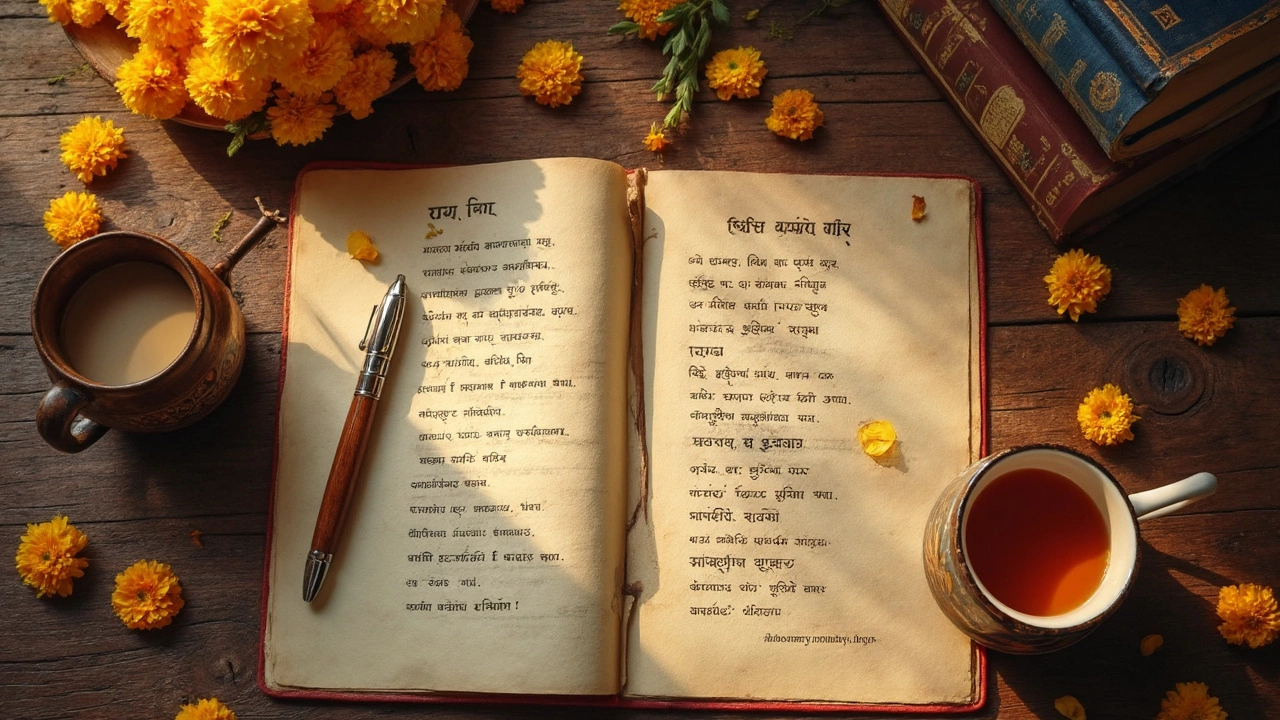
Ever stared at a tiny poem and thought, is this supposed to have more lines? Actually, short poems pack a punch, sometimes even more than long ones. Those little 2-line and 4-line poems aren't just creative shortcuts—there’s actually names and styles for them, especially in places like India where short poetry is a big thing.
Let’s cut through the confusion. Are all 2-line poems haikus? Nope, that’s actually a 3-line form. Are 4-line poems always called quatrains? Not always. The answer depends on culture, tradition, and language. And trust me, once you know the right terms, reading (or writing) these micro-masterpieces gets a whole lot more fun.
- Why Do Poems Come in 2 or 4 Lines?
- Names for 2- and 4-Line Poems
- Indian Short Poetry Styles
- Tips for Writing Your Own Short Poems
Why Do Poems Come in 2 or 4 Lines?
People love 2 line poems and 4 line poems because of how direct and catchy they are. It’s not just about making poetry shorter for the sake of it—different cultures came up with these mini-forms for a reason. Sometimes, a couple of lines can say what a whole page can’t.
In India, short poetry goes way back. Ancient Sanskrit texts and Urdu writings often used just a few lines to sum up deep thoughts or feelings. These forms work because the human brain loves simplicity and patterns. If you’ve ever remembered a couplet or a song’s hook, that’s exactly the magic at play.
- Faster impact: You can read and remember short poetry quickly. In busy lives, that makes short poems super practical.
- Easy to share: Think social media, stickers, or even a quick text. Two or four lines fit pretty much anywhere.
- Memorization: School kids in India often start poetry with these shorter forms, because they’re easier to learn and recite.
- Tradition: Classic forms like the Hindi doha (2 lines) or the English quatrain (4 lines) have been used for centuries to teach, preach, or just entertain.
Here’s a quirky fact: researchers found that people are about 40% more likely to remember a message if it’s delivered in rhyme or a tight couple of lines. No wonder advertisers and folk singers both love these forms.
Names for 2- and 4-Line Poems
Alright, let’s get straight to it. When it comes to names for these short poems, it’s easy to get mixed up. First, a 2 line poem is most commonly called a couplet. Think of a couplet as a pair, like two best buddies hanging out. Each line usually rhymes, but that’s not a strict rule—sometimes it’s just about those two lines working together as a thought or punchline. You’ll catch couplets everywhere from nursery rhymes to Bollywood lyrics.
Now for the 4 line poem. The official name is a quatrain. Four lines, simple. But don’t get fooled by the simplicity. Quatrains can carry all sorts of rhyme patterns—ABAB, AABB, even AAAA. That’s why you see quatrains in everything from English textbooks to popular ghazals.
| Number of Lines | Common Name | Typical Features |
|---|---|---|
| 2 | Couplet | Usually rhymes, delivers a quick idea |
| 4 | Quatrain | Lots of rhyme patterns, more space for a story or emotion |
But don’t stop there. Punjabi, Urdu, and Hindi poetry also use these forms but sometimes with local names. For example, in Urdu, those 2-line poems are called “Sher” and are the building blocks of ghazals. In Hindi and Sanskrit, you’ll hear “doha” for a special kind of couplet—famous ones were written by Kabir and Rahim.
So if you ever hear someone mention a couplet, quatrain, sher, or doha—they’re probably talking about these short but punchy poems. It’s not just about what they’re called, but how they’re used. That’s where short poems really shine.

Indian Short Poetry Styles
If you’ve ever read Indian poetry, you’ll notice that short poems are pretty common. Both 2 line poem and 4 line poem forms have been loved for generations. They aren’t just for school kids or lazy poets—these styles are packed with meaning and tradition.
Let’s start with two-liners. In India, the most famous one is the ‘Sher’ or ‘She’r’—basically, a two-line shayari. Urdu poetry uses shers everywhere, especially in ghazals. Each sher is a complete thought, kind of like a mic drop in two lines. Then there’s the Sanskrit 'Subhashita', a couplet that shares practical wisdom or advice.
Four-line poems pop up too—think ‘Chaupai’ from Hindi and Awadhi poetry. Chaupais are used in classics like the Ramcharitmanas. In Urdu, you’ve got the 'Ruba'i'. In fact, Persian and Urdu rubaiyat are well-loved for their tight, thoughtful messages in just four lines.
- Sher (Urdu): A compact, two-line poem, often found in ghazals.
- Chaupai (Hindi): Four lines, often part of epic poems and prayers.
- Doha (Hindi/Sanskrit): Two rhymed lines, famously used by poets like Kabir and Rahim.
- Ruba'i (Urdu/Persian): Four lines with a specific rhyme pattern, known for philosophical ideas.
The cool part? These short poetry forms aren’t just old-school. You’ll find them all over social media—think quick shayari on WhatsApp statuses or Insta poems. People love sharing emotions fast, and these time-tested styles make it easy to do that in just a few words.
Here’s a quick look at some classic forms:
| Form | Lines | Language | Popular Example |
|---|---|---|---|
| Sher | 2 | Urdu | Mirza Ghalib’s ghazals |
| Chaupai | 4 | Hindi | Ramcharitmanas by Tulsidas |
| Doha | 2 | Hindi/Sanskrit | Kabir’s dohas |
| Ruba'i | 4 | Persian/Urdu | Omar Khayyam’s rubaiyat |
So next time you see a 2 line poem or 4 line poem, you’ll know it’s not just bite-sized—it could be a sher, chaupai, doha, or ruba'i carrying generations of tradition and meaning.
Tips for Writing Your Own Short Poems
Short poems like 2 line poem or 4 line poem styles seem simple, but if you’ve ever tried, you know it’s easy to get stuck. There’s not much space, so you need your words to work extra hard. Here’s how to get it right:
- Start with strong thoughts: You only get a couple of lines. Think about one clear idea, emotion, or moment. The best short poems skip the small talk and go straight to what matters.
- Cut the fluff: Every word should count. Read your poem out loud—if there’s a word that isn’t needed, just drop it. This is especially true in popular forms like doha or couplet where space is limited.
- Play with rhymes—but don’t force them: Rhymes can make your 2 or 4 line poem catchy, but don’t twist your meaning just to make words rhyme. In Hindi and Urdu poetry, simple and direct rhymes often work better than complicated ones.
- Use everyday language: People connect more when they recognize their own way of speaking. Legendary Indian poets like Kabir or Rahat Indori are favorites partly because they keep it relatable.
- Edit and test: Show your poem to a friend. If they “get” it in one read, you’re on the right track. If not, swap out tricky words or complicated images.
If you’re feeling stuck, steal a trick from famous short forms in Indian poetry. Try writing a doha—just two lines, usually about a wise or simple truth. For four lines, look at the ruba'i—it gives you a bit more space to develop your idea.
| Form | Lines | Language |
|---|---|---|
| Doha | 2 | Hindi/Urdu |
| Couplet | 2 | English, Hindi, Urdu |
| Ruba'i | 4 | Persian, Urdu |
| Chaupai | 4 | Hindi |
Above all, keep writing! The more you play with short poetry forms, the easier it’ll get. Soon, you’ll find your own style.